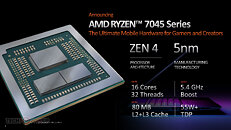- Joined
- Oct 9, 2007
- Messages
- 47,579 (7.46/day)
- Location
- Dublin, Ireland
| System Name | RBMK-1000 |
|---|---|
| Processor | AMD Ryzen 7 5700G |
| Motherboard | ASUS ROG Strix B450-E Gaming |
| Cooling | DeepCool Gammax L240 V2 |
| Memory | 2x 8GB G.Skill Sniper X |
| Video Card(s) | Palit GeForce RTX 2080 SUPER GameRock |
| Storage | Western Digital Black NVMe 512GB |
| Display(s) | BenQ 1440p 60 Hz 27-inch |
| Case | Corsair Carbide 100R |
| Audio Device(s) | ASUS SupremeFX S1220A |
| Power Supply | Cooler Master MWE Gold 650W |
| Mouse | ASUS ROG Strix Impact |
| Keyboard | Gamdias Hermes E2 |
| Software | Windows 11 Pro |
There are two distinct developments in the client processor space for AMD—first, its Ryzen 7000X3D desktop processors have managed to retain gaming performance competitiveness against Intel's fastest 13th Gen Core "Raptor Lake" processors; and second, that its Ryzen 7045HX "Dragon Range" mobile processors are picking up interest in the enthusiast-segment notebook community, where its advanced 5 nm + 6 nm process is dealing damage to 13th Gen Core mobile processors in performance/Watt, and gaming performance. Can AMD dial things up a notch? Technically, yes.
It should technically be possible for AMD to build "Dragon Range" multi-chip modules using "Zen 4" + 3D Vertical Cache CCDs (CPU complex dies), much in the same way it did for the desktop product stack. Such a processor would either have one CCD with the 3DV cache for a CPU core-count of up to 8-core/16-thread; or a contraption similar to the desktop 7950X3D, wherein one of the CCDs has 3DV cache, while the other is a regular "Zen 4" CCD, for core-counts of up to 16-core/32-thread. But will AMD build such chips? A lot would depend on the volumes of L3Ds (the 6 nm dies with the 64 MB 3D Vertical cache memory that operates at 2.5 TB/s), the production of CCDs with 3DV cache; and whether AMD is able to achieve the right performance/Watt numbers against Intel's fastest 8P+16E "Raptor Lake" mobile processors.


In an interview with Korean tech publication Quasar Zone, AMD client and business development manager Eddy Chang stated that the company would "plan products based on market conditions," in a response to a question on whether AMD could extend 3DV cache to other product segments, such as cheaper Ryzen 5 desktop SKUs, or mobile processors. The only mobile processor AMD has in its stack to which it can easily integrate 3DV cache would have to be "Dragon Range," since the engineering effort would be limited to adding a 3DV cache-equipped CCD, and optimizing the chip's power-management.
View at TechPowerUp Main Site | Source
It should technically be possible for AMD to build "Dragon Range" multi-chip modules using "Zen 4" + 3D Vertical Cache CCDs (CPU complex dies), much in the same way it did for the desktop product stack. Such a processor would either have one CCD with the 3DV cache for a CPU core-count of up to 8-core/16-thread; or a contraption similar to the desktop 7950X3D, wherein one of the CCDs has 3DV cache, while the other is a regular "Zen 4" CCD, for core-counts of up to 16-core/32-thread. But will AMD build such chips? A lot would depend on the volumes of L3Ds (the 6 nm dies with the 64 MB 3D Vertical cache memory that operates at 2.5 TB/s), the production of CCDs with 3DV cache; and whether AMD is able to achieve the right performance/Watt numbers against Intel's fastest 8P+16E "Raptor Lake" mobile processors.


In an interview with Korean tech publication Quasar Zone, AMD client and business development manager Eddy Chang stated that the company would "plan products based on market conditions," in a response to a question on whether AMD could extend 3DV cache to other product segments, such as cheaper Ryzen 5 desktop SKUs, or mobile processors. The only mobile processor AMD has in its stack to which it can easily integrate 3DV cache would have to be "Dragon Range," since the engineering effort would be limited to adding a 3DV cache-equipped CCD, and optimizing the chip's power-management.
View at TechPowerUp Main Site | Source






